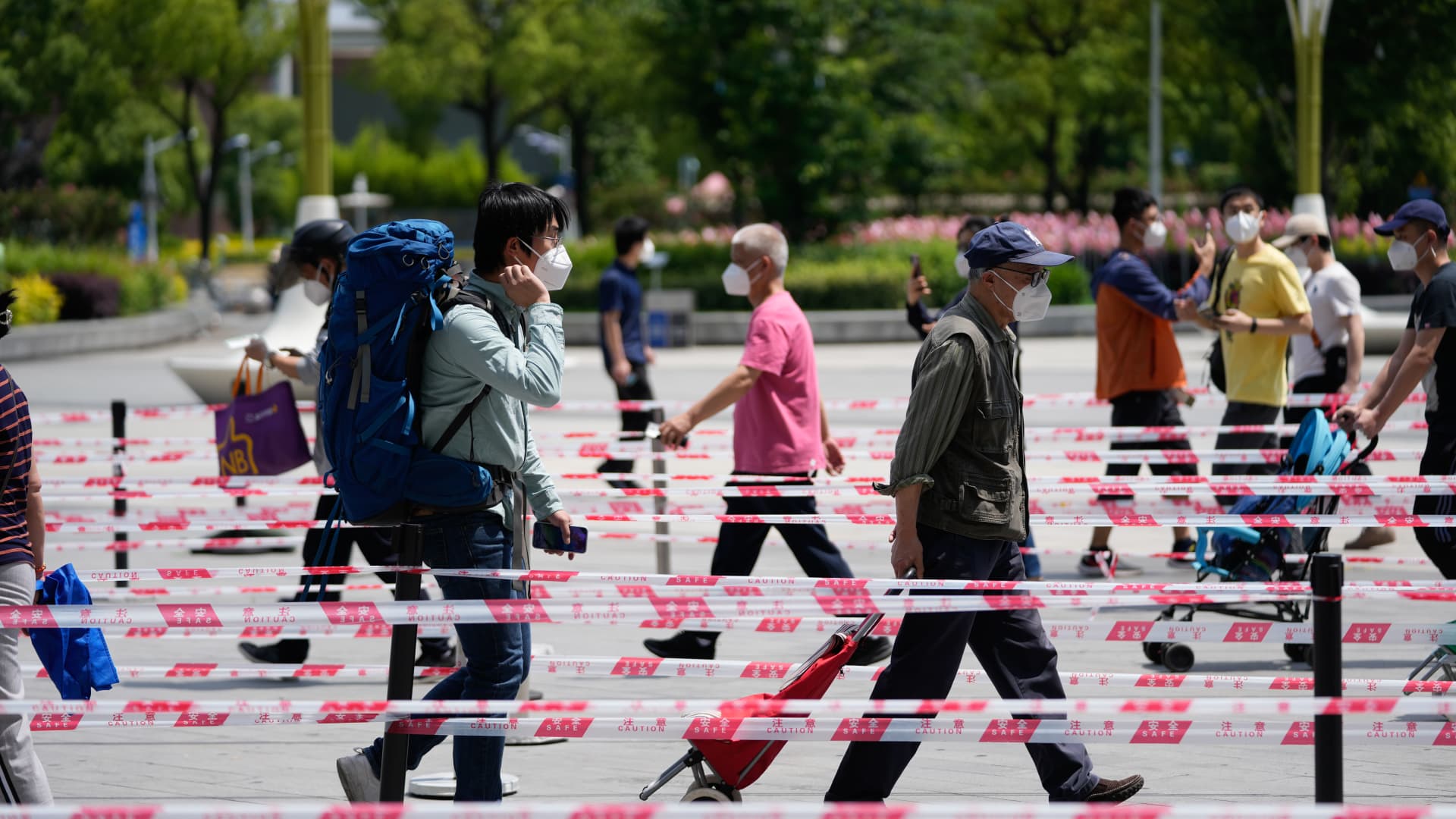Products You May Like
BEIJING — China’s economy won’t be snapping back quickly from the latest Covid outbreak, many economists predict.
Instead, they expect a slow recovery ahead.
When the pandemic first hit in 2020, China bounced back from a first-quarter contraction to grow in the second quarter. This year, the country faces a far more transmissible virus variant, overall weaker growth and less government stimulus.
The latest Covid outbreak that began in March has hit the metropolis of Shanghai the hardest. About a week ago, the city announced plans to emerge from lockdown — and fully reopen by mid-June.
“For China, the main story here is we have seen the light at the end of the tunnel. The worst of supply chain dislocations in China from Covid lockdown looks to be over,” Robin Xing, Morgan Stanley’s chief China economist, said during a webinar Friday.
“But we also think the road to recovery will likely be slow and bumpy,” Xing said.
It’s a process of fits and starts. Over the weekend, a downtown Shanghai district again banned residents from leaving their apartment complexes to conduct mass virus testing. More parts of the capital city of Beijing ordered people to work from home as the local daily case count rose — reaching 83 on Sunday, the highest for the city’s latest outbreak.
Case in point: German automaker Volkswagen, which has factories in two of this year’s hardest-hit regions, said Wednesday its China production sites were up and running, but Covid controls were disrupting supply chains.
The automaker said it was unable to provide a specific figure on production levels as the factories are joint ventures operated with local partners.
Although the national Covid case count has fallen over the last month, pockets of new cases ranging from Beijing to southwest China have prompted stay-home orders and mass testing. Freight volumes remain below normal.
“Many regions and cities have tightened restrictions at the first sign of local cases,” Meng Lei, China equity strategist at UBS Securities, said in a note last week.
“Our case studies of Shanghai, Jilin, Xi’an and Beijing show logistical and supply chain disruptions are the biggest pain points that affect production resumption,” Meng said. “Therefore work resumption is likely to be gradual rather than happening overnight.”
A policymaking cycle ‘interrupted’
The Chinese government has stuck to its stringent policy of “dynamic zero-Covid” despite this year’s emergence of the highly transmissible omicron variant.
The “most significant impact” of the Covid resurgence is that it “interrupted” the normal policymaking schedule, said Dan Wang, Shanghai-based chief economist at Hang Seng Bank China.
She said the latest wave of cases and lockdowns really only started after the central government released its annual economic plan at the “Two Sessions” parliamentary meeting in March.
In China’s heavily managed economy, this annual meeting is a critical part of a cycle for developing and implementing national policies — across departments and regions.
Supply chain disruption and lackluster consumption are manageable, but once the policy schedule is interrupted, “it’s hard to get it back to its original track quickly,” Wang said.
There are so many different economic targets that “a lot of compromises have to be made between different [government] departments,” she said. “That has made the policy process extremely slow and lagging.”
The information office for China’s State Council, the country’s top executive body, did not immediately respond to a CNBC request for comment.
Politics holds particular weight with officials this year ahead of a regular shuffle of leaders scheduled for the fall. Chinese President Xi Jinping is expected to stay on for an unprecedented third term.
Half the stimulus as in 2020
In early March at the “Two Sessions,” Beijing set targets such as GDP growth of “around 5.5%.” But that’s about 1 percentage point or more above the forecast of many investment banks — which have repeatedly slashed their China growth estimates as Covid lockdowns persist.
Wang maintains a relatively high forecast of 5.1% as she expects China to increase stimulus and ease tight Covid controls later in the summer.
But so far, nearly two months after Shanghai locked down in earnest, policymakers have yet to make major changes.
Whether in terms of interest rates or fiscal policy, the level of government stimulus is still about half of what it was during the height of the pandemic in 2020, Morgan Stanley’s Xing said.
Except for unemployment, most economic indicators have not reached levels worse than early 2020.
Among other measures, the central government has announced tax and fee cuts for small businesses, and started to cut mortgage rates. But the impact, especially on the massive real estate sector, can take time to play out.
Xing noted that even without Covid, an easing of policies on the property market would take three to six months to affect homebuying activity.
Other parts of China hum along
Still, it’s also possible that growth in China could come faster than many expect.
“The silver lining is, the experiences from the past two years suggest that a Covid-induced recession tends to end quickly, especially with prompt and powerful policy responses,” Larry Hu, chief China economist at Macquarie, said in a note last week.
For much of China, work goes on, even if there are additional virus testing requirements.
About 80% of manufacturing in southern China is back to normal. Though the region’s big city of Shenzhen shut nearly all businesses for about a week in March, moving products via truck within a province is “OK” due to very low numbers of Covid cases in the region, Klaus Zenkel, chair of the south China chapter of the EU Chamber of Commerce in China, told CNBC on Friday.
Members in the southern Guangdong province — a manufacturing hub — “are all busy, they all have work to do,” Zenkel said. He noted businesses were keeping their warehouses fuller than before to prevent a prolonged shortage issue.
But “unpredictability is there,” he said. “You don’t know what will happen.”
